Prison reform programs, ranging from making soy sauce to creating works of art or doing woodwork, have often garnered positive feedback from society and are constantly breaking annual income records at their respective prisons.
According to the Agency of Corrections, the total income from produce sales for all prisons across the nation exceeded NT$460 million (US$15 million) last year, exceeding the total income of 2012 by 13 percent.
The Taipei Prison, known for its dried tofu products, grossed NT$36 million last year from its various products, with its “customized products” getting the most attention.
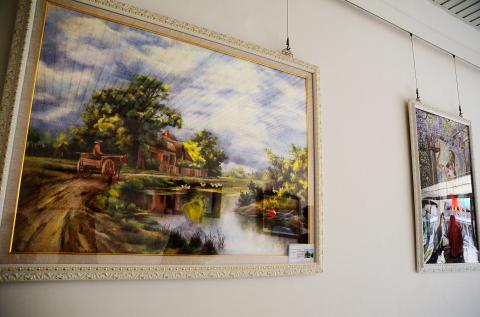
Photo: Cheng Shu-ting, Taipei Times
According to Taipei Prison Secretary Chiu Ming-wei (邱明偉), the inmates used manual labor to custom-make products as requested by civilians, adding that the prison often received requests to have family photographs reproduced in sand drawings.
The prison included sand drawings as part of its reform-program products in 2012.
There is no limit on the type of products which can be requested, Chiu said, and the prison has 18 different workshops for different kinds of products, including carpentry, ceramic art and sand drawings.
The prison initially only accepted requests for woodwork and ceramic products, limiting the choice to wooden furniture, portrait frames, tea tables, ceramic-plate paintings and flower vases, but last year hardwood furniture fitted together with mortise and tenon joints were added to the list, he added.
The prison earns between NT$200,000 and NT$300,000 every month from woodwork products alone, Chiu said.
Although ceramic arts — which involve molding, imprinting, burning and glazing — are more technique-heavy and require more manpower, which means it takes longer to manufacture the requested items, there are still no shortage of people calling in to place orders, he said.
The prison gets an income of NT$50,000 to NT$80,000 per month from ceramic arts, he added.
Governmental organizations also often place special orders for sand drawings as a special gift to some of their visitors, Chiu said.
As sand drawings pay great attention to detail and use many colors, making each drawing is an extended process requiring 30 to 40 days to finish, depending on the drawings’ complexity and size, he added.
The prison has an exhibition hall where many works produced by inmates are put up to be admired.
The drawings cover a large variety of subjects, like animals, people and even scenes of natural beauty, Chiu said.
The more exquisite the details of each drawing, the more work has to be put into the artwork by the inmates, and each drawing is worth its weight in gold, he said.
Chiu added that some of his colleagues, upon hearing that they would be transferred to other facilities, even ordered a sand drawing to remember their stay at the prison.
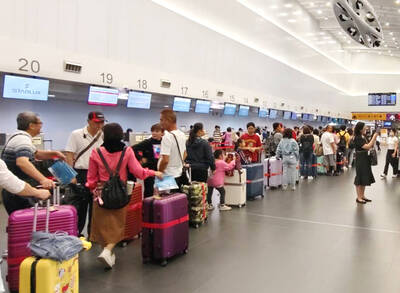
Three Taiwanese airlines have prohibited passengers from packing Bluetooth earbuds and their charger cases in checked luggage. EVA Air and Uni Air said that Bluetooth earbuds and charger cases are categorized as portable electronic devices, which should be switched off if they are placed in checked luggage based on international aviation safety regulations. They must not be in standby or sleep mode. However, as charging would continue when earbuds are placed in the charger cases, which would contravene international aviation regulations, their cases must be carried as hand luggage, they said. Tigerair Taiwan said that earbud charger cases are equipped
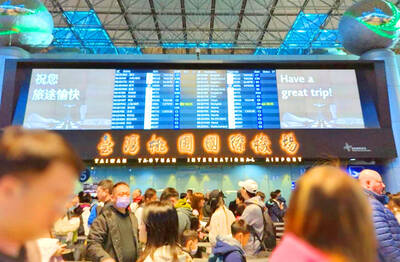
Foreign travelers entering Taiwan on a short layover via Taiwan Taoyuan International Airport are receiving NT$600 gift vouchers from yesterday, the Tourism Administration said, adding that it hopes the incentive would boost tourism consumption at the airport. The program, which allows travelers holding non-Taiwan passports who enter the country during a layover of up to 24 hours to claim a voucher, aims to promote attractions at the airport, the agency said in a statement on Friday. To participate, travelers must sign up on the campaign Web site, the agency said. They can then present their passport and boarding pass for their connecting international
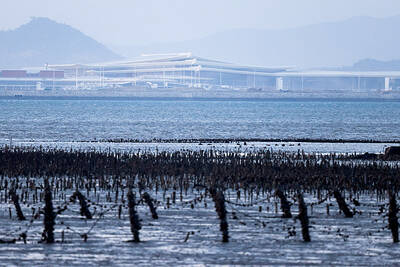
UNILATERAL MOVES: Officials have raised concerns that Beijing could try to exert economic control over Kinmen in a key development plan next year The Civil Aviation Administration (CAA) yesterday said that China has so far failed to provide any information about a new airport expected to open next year that is less than 10km from a Taiwanese airport, raising flight safety concerns. Xiamen Xiangan International Airport is only about 3km at its closest point from the islands in Kinmen County — the scene of on-off fighting during the Cold War — and construction work can be seen and heard clearly from the Taiwan side. In a written statement sent to Reuters, the CAA said that airports close to each other need detailed advanced
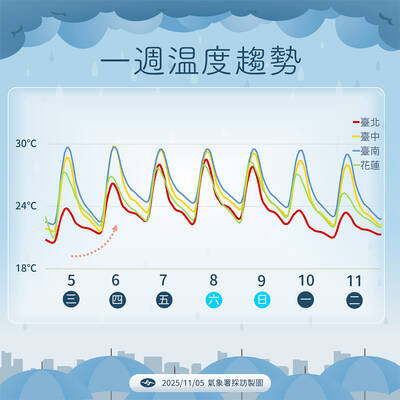
UNKNOWN TRAJECTORY: The storm could move in four possible directions, with the fourth option considered the most threatening to Taiwan, meteorologist Lin De-en said A soon-to-be-formed tropical storm east of the Philippines could begin affecting Taiwan on Wednesday next week, the Central Weather Administration (CWA) said yesterday. The storm, to be named Fung-wong (鳳凰), is forecast to approach Taiwan on Tuesday next week and could begin affecting the weather in Taiwan on Wednesday, CWA forecaster Huang En-hung (黃恩鴻) said, adding that its impact might be amplified by the combined effect with the northeast monsoon. As of 2pm yesterday, the system’s center was 2,800km southeast of Oluanbi (鵝鑾鼻). It was moving northwest at 18kph. Meteorologist Lin De-en (林得恩) on Facebook yesterday wrote that the would-be storm is surrounded by